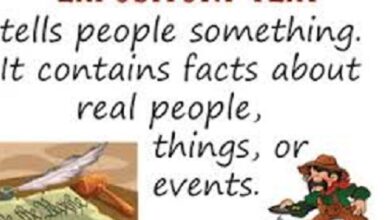Texts and its types with elaboration in detail
Texts
Texts are written documents that allow us to record all kinds of information. However, for a correct interpretation of its contents, it is necessary to be clear that each text responds to a different type, which means that it will have specific structural purposes and characteristics. Texts and its types with elaboration
Even so, it is necessary to understand that different types of text are almost never in their purest form. Each type of text can use elements of another to achieve its purposes. For example, in a narrative text, there may be elements of description. Let’s see then how many types of text exist and what are their general features.
Text types
1-Literary texts
Literary texts are those that are produced for aesthetic purposes. Through a connotative language, that is, through the use of metaphorical language, stories, ideas, feelings and dialogues that function as symbols or allegories of deep realities are exposed, and that cannot always be explained by direct language.
Due to its aesthetic nature, the care of the form of discourse is essential in literary texts, which is why the most varied literary figures are often used: metaphors, similes, hyperbole, paradoxes, onomatopoeias, etc.
2-Narrative text
It refers to all kinds of fiction stories or symbolic stories. In this type of texts, literary resources such as description, dialogues, etc. can be used in combination.
Its structure usually responds to a beginning, development, knot and outcome. Among the most common genres of narrative literary texts we have the following:
3-Lyrical text
Lyrical texts are those that express feeling and ideas from the use of poetic language full of inspiration and enthusiasm, which is why the poem is its fundamental expression. Deliberate subjectivity is one of its characteristic features. Within the lyrical texts, there is a great variety of literary genres. Among them we can name the following:
- Anthem
- Song
- Elegy
- Eclogue
- Ode
- Sonnet
- Epigram
- Calligram
- Madrigal
- Tongue twister
- Riddles
- Acrostics
- Prose poem.
4-Dramatic text
Dramatic texts are those intended for stage performance, either through dialogues or actions. That is, dramatic texts are those from which theater is made. They are usually divided into acts and each act is divided into scenes. Texts and its types with elaboration
5-Non-literary texts
Non-literary texts are all those texts whose purpose is the transmission of information or the communication of comings or messages through a denotative language, that is, through a clear, direct and pragmatic language. Some of its types are:
6-Descriptive text
It refers to the set of texts that are intended to characterize in detail a certain object, whether it is a person, animal, landscape, place, situation or thing.
7-Expositive text
These are texts that seek to present information, ideas and concepts clearly to the reader, whether from a general or specialized perspective. As an example we can name the different entries of an encyclopedia. There are at least two types of expository text: the informative and the specialized.
8-Argumentative text
The argumentative texts are those that debate ideas, theories and concepts with the purpose of expressing diverse opinions and points of view on the approach of certain topics. It has elements of the expository text, because before debating, you must present the reader with information on the subject to be discussed.
An example of argumentative text are opinion articles, literary essays and academic essays. Theoretical philosophical disquisitions can also be considered argumentative texts. For example, the book Critique to the pure reason of Immanuel Kant.
9-Information text
Are those intended to provide essential information about specific events or any matter of current interest. This type of text is essential in journalism, and can range from news of events to deep reports that serve the reader to keep updated. Texts and its types with elaboration
10-Scientific text
Scientific texts are those in which theories and concepts are developed and, in addition, present advances on scientific research of all kinds, through a rigorous structure. They usually use specialized technical language, which distinguishes them from the mere news of a scientific subject. They can combine elements of descriptive, argumentative or expository text, in addition to introducing specific elements such as the presentation of experimental results and the formulation of hypotheses.
11-Technical text
It is a clear and precise text whose purpose is to provide information on methodologies and processes to apply scientific knowledge, as well as facilitate work tools. For example: catalogs, manuals, instructions, etc.
12-Advertising text
Advertising texts are short texts intended to persuade the consumer to acquire certain goods or services. Its extension is usually not greater than one sentence.
13-Legal text
It refers to those texts for legal and judicial use, such as laws, judgments, purchase and sale documents, powers, constitutive acts, etc.
14-Normative text
It refers to the texts in which standards of behavior are indicated in the context of a given institution, formal or informal.
Administrative text
It refers to the entire universe of texts intended to formalize communication within a given institution, which includes both its workers and the instances they represent, as well as the people who use the institution (clients, students, etc.). ). For example: applications, memoranda, management reports, minutes and minutes of meetings, records, etc. Texts and its types with elaboration
15-Epistolary text, epistle or letter
Epistolary text refers to letters or communications that are established between people. The purpose of a letter is to establish communication between two or more people who, for some reason, cannot communicate directly, that is, lively. The letter develops content and appeals to elements of the narrative and the exposition.
The epistle or letter can also reach an aesthetic end. Therefore, there is the epistolary novel. For example, Dangerous Friendships of Choderlos de Laclos. Some individual letters constitute, in themselves, a work of art. For example, the epistle “De profundis” by Oscar Wilde.
16-Digital texts
Digital texts deserve a separate mention, since they assume a different level of complexity due to their production modes, their supports and the reading modes they promote. That is, digital texts use different codes but maintain the same language structures.
Thus, digital texts means all kinds of texts that are used on the web, and these can have literary and non-literary purposes (such as conventional texts), but they also go further.
Digital texts are not limited to offering direct information or facilitating interpersonal communication, but also perform functions such as indexing in search engines, links, programming languages, etc.
There are various types of digital texts, among which we can mention:
17-Unimodal digital texts
They are those that have been written or digitized in a specific processor for this and that are recognized by the acronym of the extension (doc, pdf, rtf, etc.).
In reality, these texts differ only from the texts printed on their digital media. Its content and use is conceived as that of a conventional printed text and is read in this way (diachronic reading), despite being digitized. In fact, they do not need to be read online even if they can be found on the internet and downloaded from there. Texts and its types with elaboration
18-Multimodal digital texts
Multimodal texts are those that use online editors and/or multimodal editors (that is, they integrate various functions). They can be classified into two types:
1-Multimedia
They cover a variety of texts with multiple integrated functions such as image, video and audio. Digital presentations, cybertexts, cyber literature, etc. are included in this type.
2-Hypertexts
Hypertexts are those digital texts designed specifically for the web and their potential. By definition, hypertexts break the linearity of written speech by connecting the text with other by means of links ( links ). A text on the screen acts like a digital cell that makes a body with other linked texts. Hypertexts are expressed through:
- The Wiki: hypertexts with content that comes from different contributors;
- Informational cells: immediate news publications with links to multimedia resources;
- Search engines and thematic indexes;
- The editors;
- HTML

